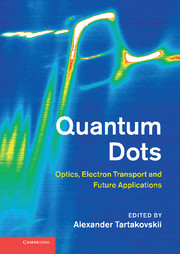Book contents
- Frontmatter
- Contents
- List of contributors
- Preface
- Part I Nanostructure design and structural properties of epitaxially grown quantum dots and nanowires
- Part II Manipulation of individual quantum states in quantum dots using optical techniques
- Part III Optical properties of quantum dots in photonic cavities and plasmon-coupled dots
- Part IV Quantum dot nano-laboratory: magnetic ions and nuclear spins in a dot
- Part V Electron transport in quantum dots fabricated by lithographic techniques from III–V semiconductors and graphene
- 15 Electrically controlling single spin coherence in semiconductor nanostructures
- 16 Theory of electron and nuclear spins in III–V semiconductor and carbon-based dots
- 17 Graphene quantum dots: transport experiments and local imaging
- Part VI Single dots for future telecommunications applications
- Index
- References
15 - Electrically controlling single spin coherence in semiconductor nanostructures
from Part V - Electron transport in quantum dots fabricated by lithographic techniques from III–V semiconductors and graphene
Published online by Cambridge University Press: 05 August 2012
- Frontmatter
- Contents
- List of contributors
- Preface
- Part I Nanostructure design and structural properties of epitaxially grown quantum dots and nanowires
- Part II Manipulation of individual quantum states in quantum dots using optical techniques
- Part III Optical properties of quantum dots in photonic cavities and plasmon-coupled dots
- Part IV Quantum dot nano-laboratory: magnetic ions and nuclear spins in a dot
- Part V Electron transport in quantum dots fabricated by lithographic techniques from III–V semiconductors and graphene
- 15 Electrically controlling single spin coherence in semiconductor nanostructures
- 16 Theory of electron and nuclear spins in III–V semiconductor and carbon-based dots
- 17 Graphene quantum dots: transport experiments and local imaging
- Part VI Single dots for future telecommunications applications
- Index
- References
Summary
Introduction
In 1998, Daniel Loss and David DiVincenzo published a seminal paper describing how semiconductor quantum dots could be used to create spin qubits for quantum information processing [28]. They recognized that a single spin in a magnetic field forms a natural two-level system that can serve as a quantum bit. Moreover, owing to the weak magnetic moment of the electron, the spin is relatively well isolated from the environment leading to long coherence times. To confine single spins, Loss and DiVincenzo envisioned the quantum dot architecture shown in Fig. 15.1. A GaAs/AlGaAs heterostructure confines electrons to a two-dimensional electron gas (2DEG). Depletion gates are fabricated on top of the structure to provide a tunable confinement potential, trapping a single electron in each quantum dot. Neighboring quantum dots are tunnel coupled, with the coupling strength controlled by the electrostatic potential. The orientation of a single spin can be controlled by using electron spin resonance (ESR), while nearest-neighbor coupling is mediated by the depletion gate tunable exchange interaction.
It is fair to say that in 1998 many of the requirements of the Loss–DiVincenzo proposal had not been implemented, starting with the most basic necessity of a single electron lateral quantum dot [8]. The purpose of this chapter is to describe several experiments inspired by the Loss–DiVincenzo proposal. Many powerful experiments have been performed since 1998 and, given the space constraints here, we cannot give each experiment the attention it deserves.
- Type
- Chapter
- Information
- Quantum DotsOptics, Electron Transport and Future Applications, pp. 255 - 276Publisher: Cambridge University PressPrint publication year: 2012



